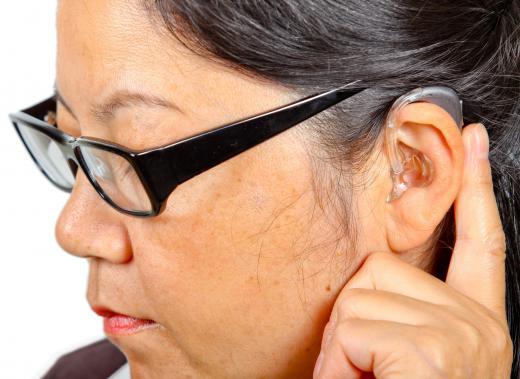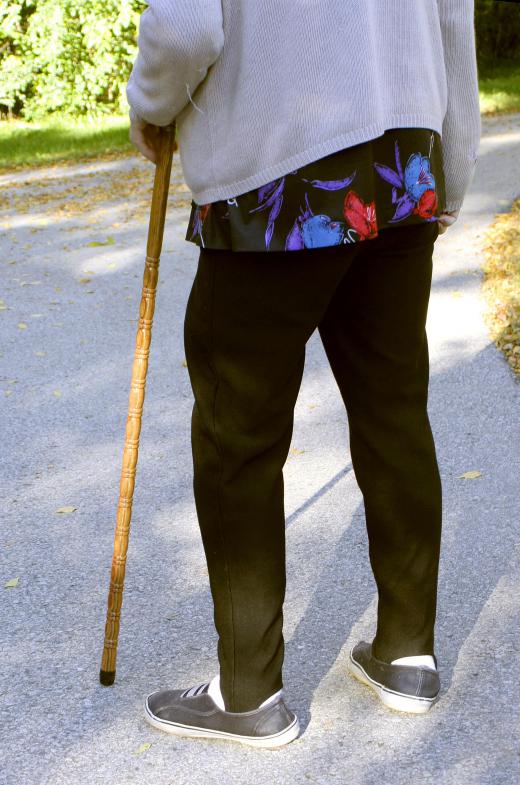What are the Different Types of Adaptive Devices?
Adaptive devices are appliances or technologies used by people with physical limitations or disabilities to help them lead lives that are as independent as possible. These devices can improve a person's mobility and level of function as well as the ability to perform daily activities, such as dressing, bathing, and eating. Adaptive or assistive devices may be used to help people hear, see, and communicate. Students with disabilities may use adaptive technologies to help them access information, participate in classroom activities, and complete assignments.
Aids that improve a person's ability to get from place to place are common types of adaptive devices. Canes, crutches, and walkers help people with painful joints or impaired balance to walk safely and for longer distances, and electric scooters can be used for errands and outdoor activities. For people who are not ambulatory, wheelchairs may be outfitted with adaptive technologies, such as specialized wheels or frames, that allow users to participate in sports or move around on uneven surfaces. Electric wheelchairs can be equipped for propulsion using small movements of the head or controlled air flow through the mouth. Positioning aids and seating systems can be designed to maximize function and comfort.

Adaptive devices can make life easier for people who have trouble with daily tasks, such as bathing, dressing, or meal preparation. There are reaching tools and gadgets for putting on socks or buttoning shirts. Grab bars and shower chairs in the bathroom make bathing safer and more manageable for many people. Stroke victims with limited mobility on one side, for example, can use adaptive devices that allow them to open cans and cut food independently.

Common adaptive devices used by visually or hearing-impaired people include corrective lenses, reading machines, hearing aids, and Teletypewriting Device for the Deaf/Teletypewriter (TTD/TTY) devices. Communication boards and speech output devices are available for people who do not use standard speech to communicate. With the advent of computer-aided technology, people with communication difficulties also have many other options at their disposal, including accessible computer programs, touch screens, and pointing devices that are operated by eye movements.

The variety of adaptive devices now available has helped people maximize their functional capacity across the age and disability spectrum. Children with disabilities can go to school with their peers. With the help of adaptive devices, adults and seniors can enjoy active participation in their communities and continued independence at home.
AS FEATURED ON:
AS FEATURED ON:


















Discussion Comments
Some people might not realize that public libraries often have adaptive technology devices available. It's not just limited to the "talking books" available to the visually impaired.
Our branch has several different things that can help our patrons with disabilities. We have some computer tables that are adjustable height to suit a wheelchair, for instance, and we have a CCTV that can enlarge any book, crossword puzzles, etc. Some of our regulars use this all the time. One older lady who lives in walking distance of our branch brings in all her mail to read this way.
We can also help people with tapping the adaptive technology that your computer might already have, beginning with how to zoom and make text look larger. Stop by your public library and see what they can do for you!
I think a lot of people don't realize everything they can do to be more comfortable with independent living, some of it without purchasing special equipment. My uncle has terrible arthritis in his hands and it's hard to grip. He ties a dish towel to his refrigerator door so that he can pull it open without having to grip tight, for instance. (Fortunately, he has a door with an open handle. Older people who can foresee having this problem might want to keep it in mind when buying a new fridge!)
The other thing he did that was really helpful was take out all the doorknobs in his house and replace them with levers--much easier on the hands. My dad tried to help him with this but after he put one in upside down, they decided to have a handyman do it! It wasn't very expensive as they know one of those jack-of-all-trades guys who works cheap.
Post your comments